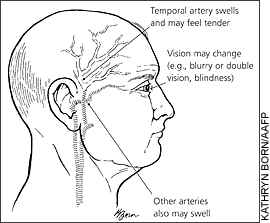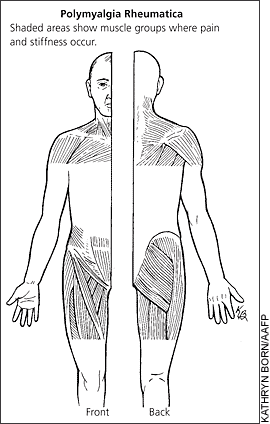
Am Fam Physician. 2006;74(9):1557-1560
See related article on giant cell arteritis and polymyalgia rheumatica.
What is giant cell arteritis?
Arteritis (ar-ter-EYE-tis) is when your blood vessels (the tubes that carry your blood) become swollen. Giant cell arteritis (or GCA) usually affects the artery on the side of your head. This is called the temporal artery.
If you have GCA your temporal artery may feel tender. GCA can stop blood from getting to your eye. If it is not treated, you could become blind.

What is polymyalgia rheumatica?
Polymyalgia rheumatica (pol-lee-my-AL-jahroo-MATT-tick-ah, or PMR) is when the muscles of your neck, shoulders, hips, and thighs become swollen. If you have PMR, these muscles may be painful and stiff. Even though the muscles are swollen, it may feel like the pain is in your joints.
What causes these conditions?
No one knows what causes GCA and PMR. Older age may be one cause. They also may be caused by a problem with your immune system or by an infection.
Who gets these conditions?
You are more likely to get these conditions if you are older than 50 years. They are most common in women between 70 and 80 years of age. GCA and PMR often happen together, so if you have one, your doctor should check for the other.
What are the symptoms?
If you have GCA you may have a headache on one side of your head. This may be different from other headaches. Some people have painful headaches when they chew. The most serious symptom is a change in your vision. You may have blurry vision, double vision, or blindness.
If you have PMR you may have stiffness in the muscles around your neck, shoulders, and hips. It may be worse in the morning or when you have been in one position for a long time. The aches and pains usually begin suddenly.
It is important to discuss your symptoms with your doctor.

How can my doctor tell if I have GCA and PMR?
Your doctor can do a blood test. If your doctor thinks you have GCA, you may need to have a temporal artery biopsy. This is when a surgeon takes a small piece of your temporal artery to look at under the microscope.
How are these conditions treated?
GCA and PMR are treated with steroids (medicines that lessen the swelling) like prednisone. Steroid treatment should make you feel better in a few days or weeks. You may need treatment for up to two years to stop the conditions from coming back. Taking steroids for a long time can raise your blood pressure and your blood sugar level, or weaken your bones. Your doctor will need to keep checking for these side effects during your treatment.
Where can I get more information?
Your doctor
Arthritis Foundation
Web site:http://www.arthritis.org
American College of Rheumatology
Web site:http://www.rheumatology.org/public/factsheets/pmr_new2.asp?aud=pat
American Academy of Family Physicians
Web site:https://familydoctor.org
National Institute of Arthritis and Musculoskeletal and Skin Diseases
Web site:http://www.niams.nih.gov/hi/topics/polymyalgia/index.htm
Mayo Clinic
Web site:http://www.mayoclinic.com/health/polymyalgia-rheumatica/DS00441/DSECTION=1&;